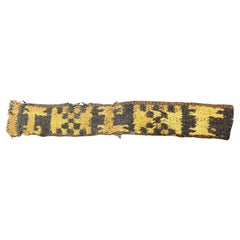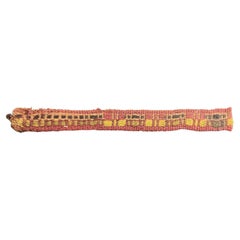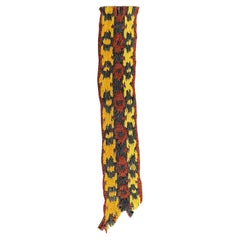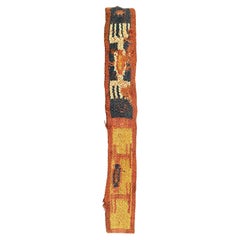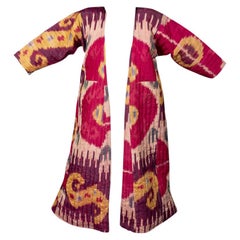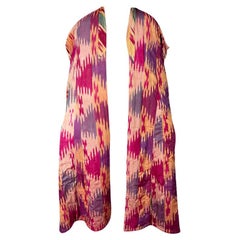MUZEION
to
93
87
9
8
5
5
3
2
1
1
1
1
1
3
2
1
1
Pre-Columbian Inka Textile Fragment - Peru, Ex Ferdinand Anton
Located in San Pedro Garza Garcia, Nuevo Leon
Pre-Columbian Inka Textile Fragment - Peru, Ex Ferdinand Anton decorated with checkerboard and llama designs.
It is a wonder to behold antiquities such as a Pre-Columbian Textiles, an authentic piece of art that has been preserved for centuries and that survives generation after generation. Textiles are infinitely more delicate than wood, metal, or rock artifacts...
Category
Antique 15th Century and Earlier Quilts and Blankets
Materials
Textile
Chancay Pre-Columbian Textile Fragment, Peru ca 1100-1400 AD, Ex Ferdinand Anton
Located in San Pedro Garza Garcia, Nuevo Leon
It is a wonder to behold antiquities such as a pre-Columbian textiles, an authentic piece of art that has been preserved for centuries and that survives generation after generation. Textiles are infinitely more delicate than wood, metal, or rock artifacts...
Category
Antique 15th Century and Earlier Quilts and Blankets
Materials
Textile
Chancay Pre-Columbian Textile Fragment, Peru ca 1100-1400 AD, Ex Ferdinand Anton
Located in San Pedro Garza Garcia, Nuevo Leon
It is a wonder to behold antiquities such as a pre-Columbian textiles, an authentic piece of art that has been preserved for centuries and that survives generation after generation. Textiles are infinitely more delicate than wood, metal, or rock artifacts...
Category
Antique 15th Century and Earlier Quilts and Blankets
Materials
Textile
Chancay Pre-Columbian Textile Fragment, Peru ca 1100-1400 AD, Ex Ferdinand Anton
Located in San Pedro Garza Garcia, Nuevo Leon
Pre-Columbian textile fragment. It is a wonder to behold antiquities such as a pre-Columbian textiles, an authentic piece of art that has been preserved for centuries and that survives generation after generation. Textiles are infinitely more delicate than wood, metal, or rock artifacts...
Category
Antique 15th Century and Earlier Quilts and Blankets
Materials
Textile
Beautiful Ikat Munisak, Uzbekistan, 19th Century
Located in San Pedro Garza Garcia, Nuevo Leon
A beautiful Ikat Munisak – a woman’s uzbek robe – in traditional pomegranate design symbolizing fertility. It has a square patch in Magenta with a flower mo...
Category
Antique 15th Century and Earlier Asian Antiquities
Materials
Cotton
Ikat Chyrpy, Central Asia
Located in San Pedro Garza Garcia, Nuevo Leon
Striking hand-woven chyrpy with a checkered triangle pattern in vibrant colours. Women in Uzbekistan and Northern Afghanistan wore this outdoor veiling garment (paranja/chrypy) in tr...
Category
Antique 15th Century and Earlier Asian Antiquities
Materials
Cotton
Magnificent Silk Ikat Chapan, Uzbekistan, Xix Century
Located in San Pedro Garza Garcia, Nuevo Leon
Ikat Chapan – a man’s uzbek coat – Style Robe with exceptionally rich colour and dynamic pattering. Viewers may become lost in this ikat’s intertwining mot...
Category
Antique 19th Century Uzbek Antiquities
Materials
Cotton
Ikat Chyrpy, Central Asia
Located in San Pedro Garza Garcia, Nuevo Leon
Spectacular hand-loomed Chyrpy with a checkered pattern, finished with a remarkable white wavy cotton edging. Women in Uzbekistan and Northern Afghanistan wore this outdoor veiling g...
Category
Antique 15th Century and Earlier Asian Antiquities
Materials
Cotton
Egyptian Mummy Mask, Late Period, ca. 700-30 B.C.
Located in San Pedro Garza Garcia, Nuevo Leon
Carved hardwood mummy mask having a pink-brown painted ground, painted black eyes and brows. Wearing a black headband. Eyes and brows are restored. Scattere...
Category
Antique 15th Century and Earlier Egyptian Masks
Materials
Hardwood
Chancay Large Standing Female Figure
Located in San Pedro Garza Garcia, Nuevo Leon
Cream slip pottery, large standing female figure with arms raised. Nicely painted red and chocolate-brown face, with a finely detail geometric headband. Scattered mineral deposits on...
Category
Antique 15th Century and Earlier South American Native American Objects
Materials
Pottery
Chancay Large Standing Female Cuchimilco
Located in San Pedro Garza Garcia, Nuevo Leon
Large standing female figure with raised arms. Relief facial features, with red-orange and chocolate brown painted decoration, on a cream slip ground. Crossed straps on her chest, an...
Category
Antique 15th Century and Earlier South American Native American Objects
Materials
Pottery
Chancay Large Standing Female Cuchimilco
Located in San Pedro Garza Garcia, Nuevo Leon
Cream slip pottery, classical type large standing female figure with arms raised. Dark chocolate painted details, geometric decorated headband. Scattered mineral deposits on the surface. Repaired from approximately twenty original pieces with restoration over the break lines.
Provenance: Private Danish...
Category
Antique 15th Century and Earlier South American Native American Objects
Materials
Pottery
Pre-Columbian Nazca Textile, Stepped Zig-Zag Design, Nazca Peru 200-400 AD
Located in San Pedro Garza Garcia, Nuevo Leon
Complete Pre-Columbian Nazca textile with stepped zig-zag design in yellow, ochre red, and brown/black shades with yellow fringes.
Category
Antique 15th Century and Earlier Peruvian Pre-Columbian Antiquities
Materials
Textile
Original Ptolemaic Egyptian Cartonnage Mask
Located in San Pedro Garza Garcia, Nuevo Leon
Mummy mask with golden complexion. He wears a striated tripartite wig retained by a knotted headband and decorated on the front with an oudjat (eye of horus) and globules (circles); ...
Category
Antique 15th Century and Earlier Egyptian Egyptian Mounted Objects
Materials
Stucco
Magnificent Pre-Columbian Nazca-Huari Imperial Feather Tunic
Located in San Pedro Garza Garcia, Nuevo Leon
Large Nazca-Huary feathered panel. A variety of different colored feathers were carefully cut and attached together creating geometric patterns, composing a symmetrical design. Mount...
Category
Antique 15th Century and Earlier Peruvian Pre-Columbian Antiquities
Materials
Feathers
Upper Egyptian Sarcophagus Lid in Polychrome Wood, EU Passport & Documentation
Located in San Pedro Garza Garcia, Nuevo Leon
Monumental upper Sarcophagus lid in polychrome wood. Late period, Saïte dynasty 711- 332 BC.
Provenance: Private European Collection.
Category
Antique 15th Century and Earlier Egyptian Egyptian Figurative Sculptures
Materials
Wood
Black Granite Maharaja Torso, 18th Century, India
Located in San Pedro Garza Garcia, Nuevo Leon
Black Granite Maharaja Torso with a big pearl necklace on his powerful chest showing pranayama respirations and a crown on the forehead. Long mustache and royal attributes. Maharaja is sanskrit for "great ruler" or "great king". This beautiful piece features a custom polished green ubatuba granite base.
The tradition of Indian sculpture is the oldest in the world, dating back to the Indus Valley...
Category
Antique 18th Century Indian Figurative Sculptures
Materials
Granite
Stunning Silver Monstrance, France, 19th Century
Located in San Pedro Garza Garcia, Nuevo Leon
Immaculate silver monstrance or ostensorium over a quadripod rectangular base, decorated with wine branches and small angels heads. French work from ...
Category
Antique 19th Century French Religious Items
Materials
Silver
Han Dynasty Standing Horse Trainer “Palafrenieri”
Located in San Pedro Garza Garcia, Nuevo Leon
Huge hollow molded terracotta, standing male figure wearing a hip-length multi-layered robe with a collared neck. Implements suspended from his waist, holding a staff in his right ha...
Category
Antique 15th Century and Earlier Han Antiquities
Materials
Terracotta
Pre-Columbian Nazca Stepped Textile Poncho, Nazca Peru, 200-400 AD
Located in San Pedro Garza Garcia, Nuevo Leon
Nazca Tunic/Poncho of stepped design and fringe in yellow ocher, burgundy and brown. Perfect condition, museum quality.
Category
Antique 15th Century and Earlier Peruvian Pre-Columbian Tapestries
Materials
Textile
Elegant Sandstone Sculpture of Apsara Playing Sitar, 18th Century, India
Located in San Pedro Garza Garcia, Nuevo Leon
Elegant sandstone sculpture of apsara playing sitar with missing arms with a beautiful face and a high tiara and pleated robes. It comes with a custom Lucite base.
Weight: 21.3 lb...
Category
Antique Early 18th Century Indian Figurative Sculptures
Expressive Sandstone Sculpture of Apsara Playing Sitar, 18th Century India
Located in San Pedro Garza Garcia, Nuevo Leon
Sandstone sculpture of Apsara playing sitar with dancing pose in front of a garland arch. Covered with rests of stucco and old painting with beautiful face expression and flower lotus tiara...
Category
Antique 18th Century Indian Figurative Sculptures
Materials
Sandstone
Sacred Conversation about Prophets and False Prophets, Interchangeable Triptych
Located in San Pedro Garza Garcia, Nuevo Leon
Oil on canvas interchangeable triptych painting by Pablo Szmulewicz, 2001
Dimensions: 55" H x 118" W
This triptych painting is special not only for its bright colors and vivid fi...
Category
2010s Argentine Contemporary Art
Materials
Canvas
Striped Inca Pre-Columbian Textile, Peru, circa 1400-1532 AD, Ex Ferdinand Anton
Located in San Pedro Garza Garcia, Nuevo Leon
Earth tones adorn this striped pattern pre-Columbian textile. These piece is mounted on a black shadowbox frame.
It is a wonder to behold antiquities such as a pre-Columbian textiles, an authentic piece of art that has been preserved for centuries and that survives generation after generation. Textiles are infinitely more delicate than wood, metal, or rock artifacts -- so the existence of these pieces after hundreds and thousands of years is exceptional. These textiles maintain their vibrant colors, natural threads, and their unique, historical designs.
Provenance: This textile comes from the collection Ulrich Hoffmann, Stuttgart and former collection of the archaeologist Ferdinand Anton...
Category
Antique 15th Century and Earlier Peruvian Pre-Columbian Antiquities
Materials
Textile
Vivid Huari Pre-Columbian Textile, Peru, Ex Ferdinand Anton
Located in San Pedro Garza Garcia, Nuevo Leon
Pre-Columbian textile fragment with wave like patterns woven in bright colors. Framed in a black shadow box.
It is a wonder to behold antiquities such as a pre-Columbian textiles, an authentic piece of art that has been preserved for centuries and that survives generation after generation. Textiles are infinitely more delicate than wood, metal, or rock artifacts - so the existence of these pieces after hundreds and thousands of years is exceptional. These textiles maintain their vibrant colors, natural threads, and their unique, historical designs.
Provenance: This textile comes from the collection Ulrich Hoffmann, Stuttgart and former collection of the archaeologist Ferdinand Anton...
Category
Antique 15th Century and Earlier Peruvian Pre-Columbian Antiquities
Materials
Textile
Abstract Paracas Precolumbian Textile, Peru, 1100-1400 AD, Ex Ferdinand Anton
Located in San Pedro Garza Garcia, Nuevo Leon
Earth tones pre-Columbian textile fragment with abstract embroidered figures. This piece is framed in a black shadowbox.
It is a wonder to behold antiquities such as a pre-Columbian textiles, an authentic piece of art that has been preserved for centuries and that survives generation after generation. Textiles are infinitely more delicate than wood, metal, or rock artifacts -- so the existence of these pieces after hundreds and thousands of years is exceptional. These textiles maintain their vibrant colors, natural threads, and their unique, historical designs.
Provenance: This textile comes from the collection Ulrich Hoffmann, Stuttgart and former collection of the archaeologist Ferdinand Anton...
Category
Antique 15th Century and Earlier Peruvian Pre-Columbian Antiquities
Materials
Textile
Striped Inca Pre-Columbian Textile, Peru, circa 1400-1532 AD, Ex Ferdinand Anton
Located in San Pedro Garza Garcia, Nuevo Leon
Earth tones adorn this striped pattern pre-Columbian textile.
It is a wonder to behold antiquities such as a pre-Columbian textiles, an authentic piece of art that has been preserved for centuries and that survives generation after generation. Textiles are infinitely more delicate than wood, metal, or rock artifacts...
Category
Antique 15th Century and Earlier Peruvian Pre-Columbian Antiquities
Materials
Textile
Intricate Pre-Columbian Textile, Peru Ex Ferdinand Anton
Located in San Pedro Garza Garcia, Nuevo Leon
Extremely detailed yellow embroidered Pre-Columbian textile fragment with hints of red from the Chancay culture in Peru. This piece is framed in a black shadowbox.
It is a wonder to behold antiquities such as a Pre-Columbian textiles, an authentic piece of art that has been preserved for centuries and that survives generation after generation. Textiles are infinitely more delicate than wood, metal, or rock artifacts -- so the existence of these pieces after hundreds and thousands of years is exceptional. These textiles maintain their vibrant colors, natural threads, and their unique, historical designs.
Provenance: This textile comes from the collection Ulrich Hoffmann, Stuttgart and former collection of the archaeologist Ferdinand Anton...
Category
Antique 15th Century and Earlier Peruvian Pre-Columbian Antiquities
Materials
Textile
Pre-Columbian Warrior Banner, Chimu, Peru, circa 1100-1476 AD
Located in San Pedro Garza Garcia, Nuevo Leon
Pre-Columbian ornamental banner with fringes composed of warriors/divinities holding figures in their hands, surrounded by geometric frets. Two-headed birds in alternating colors decorate the top and bottom of the banner. This one-of-a-kind tapestry has preserved its vibrant original colors and fibres. Professionally cleaned.
Provenance: Private European Collection
Textiles from elite Chimu tombs include elaborate gauzes, embroidery, painted plain weave and tapestry, and three-dimensional fibre sculptures. Among others, shades of yellow and brown, scarlet, white, lavender-blue and olive green were the colors used. Birds and a deity wearing a crescent-like headdress have been the most popular decorative motifs.
Many Chimu textiles...
Category
Antique 15th Century and Earlier Peruvian Pre-Columbian Antiquities
Toba Batak Singa House Ornament, Sumatra, Indonesia 20th Century, Ex-Sotheby's
Located in San Pedro Garza Garcia, Nuevo Leon
Large carved hardwood ornamental structure used as a support and a decorative frontispiece. It bears a stylized face embedded within an ornately carved and painted geometric pattern....
Category
20th Century Indonesian Tribal Tribal Art
Materials
Hardwood
Maharaja Granite Torso
Located in San Pedro Garza Garcia, Nuevo Leon
Maharaja granite torso with dagger and offerings, bell chain and dhotti.
Category
Antique 18th Century Indian Sculptures and Carvings
Materials
Granite
$18,750
Complete Granite Figure of Shiva
Located in San Pedro Garza Garcia, Nuevo Leon
Complete granite figure of Shiva showing his attributes in a standing hieratic pose, fully dressed and jeweled in royal regalia with tiara on a high pedestal with a flaming halo. Lat...
Category
Antique 18th Century Indian Sculptures and Carvings
Materials
Granite
Supernatural Being, Pre-Columbian Gold Pendant, Costa Rica, circa 800 to 1500 AD
Located in San Pedro Garza Garcia, Nuevo Leon
Southern Costa Rica or Western Panama, circa 800 to 1500 AD. A very fine example of the goldwork of the Veraguas-Chiriqui-Diquis region. A pendant in Carbonera style of a supernatural being, a composite monster with human torso and feline (probably jaguar) head. The figure is set in a frame decorated with little animal heads, one at each corner. The hands have also turned into animal heads. In place of genitalia is a stylized serpent head suspended by a twisted cord that was supposed to continue across the frame. A minor casting accident prevented it form being attached to the frame. A modern goldsmith would solder in two short lengths of twisted wire, but the ancient goldsmith did not have the equipment to make such repair. A double thread ending in spirals goes across the frame behind the neck of the figure, helping to fill up the frame and avoiding a large empty space. The word "thread" reminds us that the twisted and straight cords were, in the original wax model of the pendant really extruded wax threads, turned into metal by the lost wax (cire perdue) process. The braid pattern on the frame is illusory, just two twisted threads of extruded wax laid side by side. The goldsmith made the toes out of extruded wax thread too, very decorative as well. The piece comes with a certificate of authenticity by Mr. Robert Sonin, 5 May 2006. ref. photo roll 3301. A world renowned expert on Pre-Columbian Artifacts...
Category
Antique 15th Century and Earlier Costa Rican Pre-Columbian Figurative Sc...
Materials
Gold
Museum Quality Pre-Columbian Gold Twin Figures Pendant, circa 800 to 1500 AD
Located in San Pedro Garza Garcia, Nuevo Leon
Southern Costa Rica/Western Panama, circa 800 to 1500 AD. Gold Veraguas-Chiriqui-Diquis twin figure pendant cast by the lost-wax (cire perdu) grasping an imaginary club with their claws, with bat ears and pop out eyes and each figure ending in the shape of a jaguar tooth, symbolizing the power of the jaguar and the ability to see in the dark; The casting process did not go entirely smoothly. Part of his mold, on the side of the proper right figure (viewer's left side), did not fill with metal. The Pre-Columbian goldsmith carried out a superb repair, probably making a wax patch and pouring gate on the gold pendant, then enclosing it in a new mold and pouring in more metal. The patch is hardly visible on the outside. A modern goldsmith, who cannot do it as well, would use his gas torch to solder on a patch. The gold is of such high grade or karat, possibly unalloyed native gold...
Category
Antique 15th Century and Earlier Costa Rican Pre-Columbian Figurative Sc...
Materials
Gold
Sacred Silver and Conch Shell Trumpet, Tibet, 19th Century
Located in San Pedro Garza Garcia, Nuevo Leon
Conch shell recipient and container for holy water used in ceremonies. Known as “Buddha ears”, they were mounted as a sound instrument. Such shells are important ritual objects in Tibetan Buddhism...
Category
Antique 19th Century Tibetan Tibetan Scholar's Objects
Materials
Silver
Monumental Buddha Torso White Marble Sculpture - Tang Dynasty China 618-907 AD
Located in San Pedro Garza Garcia, Nuevo Leon
Beautiful and impressive early Tang white marble sculpture of headless Buddha, dressed in an elegant pleated toga. China. 618-907 AD. A true collectors piece.
This magnificent piece...
Category
Antique 15th Century and Earlier Chinese Tang Antiquities
Materials
Marble
Magnificent Court Attendants in Terracotta - Ming Dynasty, China 1368-1644 AD TL
Located in San Pedro Garza Garcia, Nuevo Leon
A magnificent pair of male and female courtiers from the Ming Dynasty (1368-1644 CE) in excellent condition. They are wearing traditional Daopao robes in green and black garments wit...
Category
Antique 15th Century and Earlier Chinese Ming Antiquities
Materials
Terracotta
Superb Set of 5 Elegant Court Attendants, Ming Dynasty, 1368-1644 AD TL Tested
Located in San Pedro Garza Garcia, Nuevo Leon
A stunning set of 5 graceful terracotta figurines from the Ming Dynasty '1368-1644' AD. These elegant attendants are standing on a yellow glazed lotus flower over a high hexagonal green plinth and wear fine robes in matching green and yellow glazes. The unglazed areas have pigmented colors in red, black and white. Each is carrying essential offerings for the royal family. The head is detachable as often seen on the larger figures from this period. Meticulously detailed facial expressions have been hand-painted.
Condition: Mint, finely preserved glaze and pigment, undamaged and no repairs.
Provenance: Ex. Danish Collection.
This set is guaranteed authentic and comes with a Certificate of Authenticity and TL Test from Laboratory Kotalla in Germany (The Oldest Thermoluminescence Testing Laboratory in the World).
Dimensions: Average 54 H cms
Burial figurines of graceful dancers, mystical beasts, and everyday objects reveal both how people in early China approached death and how they lived. Since people viewed the afterlife as an extension of worldly life, these figurines, called mingqi, sometimes referred as “spirit utensils” or “vessels of ghosts” disclose details of routine existence and provide insights into belief systems over a thousand-year period.
The Ming dynasty was the ruling dynasty of China – then known as the Empire of the Great Ming – for 276 years (1368–1644 AD). Founded by Chu Yuan-chang, the rebel leader that was successful in removing the mongols from the throne. Chinese control was re-asserted in China and eastern Asia. Literature became more important, schools were created, and the justice system was reformed. The Ming dynasty is described by some as "one of the greatest eras of orderly government and social stability in human history,” was the last imperial dynasty in China ruled by ethnic Han Chinese.
The practice of burying ceramic objects with the deceased went into decline from the 10th to the 14th Century AD. There was a revival in placing miniature representations of glazed terracotta objects such a furniture, food offerings, horses, miniature statues...
Category
Antique 15th Century and Earlier Chinese Ming Antiquities
Materials
Terracotta
Eastern Han Dynasty Terracotta Model of a Paper Mill , China '206BC - 220AD'
Located in San Pedro Garza Garcia, Nuevo Leon
Slab pottery constructed Model of a Paper Mill, in Green and Cream Color Glazed Terracotta having a peaked roof – open walled form with a mechanical pounder and a large round storage container. Light blue-green mottled glazed surface with some iridescence patina to the glaze. The Iridescence is a refraction of the layers on the glass that produces multicolor hues & metallic luster, and only develops after one thousand years of being buried in the ground. An unquestionable mark of antiquity, impossible to falsify.
Han Dynasty, dated 206 B.C-220 A.D.
Condition: Excellent, wear commensurate with age, an unusual example.
This fantastic piece is accompanied by a Certificate of Authenticity.
Sculptural effigies of domesticated animals were often interred in the tombs of nobility and elite members of the social hierarchy. Models like this one were made to represent everything from simple goat or pig pens to the most elaborate towers and palaces. Because very few ancient Chinese buildings have survived intact, these models, along with descriptions from ancient texts, give a good representation of what the buildings might have looked like.
Burial figurines of graceful dancers, mystical beasts, and everyday objects reveal both how people in early China approached death and how they lived. Since people viewed the afterlife as an extension of worldly life, these figurines, called mingqi, sometimes referred as “spirit utensils” or “vessels of ghosts” disclose details of routine existence and provide insights into belief systems over a thousand-year period. For the first time in Chinese history, we have images of rural and daily life during the Han in the form of contemporary records...
Category
Antique 15th Century and Earlier Chinese Han Antiquities
Materials
Terracotta
Eastern Han Dynasty Terracotta Barn Workshop, China '206BC - 220AD' Ex-Museum
Located in San Pedro Garza Garcia, Nuevo Leon
Slab pottery constructed barn workshop having a peaked roof – open walled form with a mechanical pounder and a large round covered storage container. Light blue-green mottled glazed surface with some iridescence patina to the glaze.
Condition: Intact, excellent condition, an unusual example.
Provenance: The Living Torah Museum, Brooklyn; ex. Sands of Time, 2002.
Sculptural effigies of domesticated animals were often interred in the tombs of nobility and elite members of the social hierarchy. Models like this one were made to represent everything from simple goat or pig pens to the most elaborate towers and palaces. Because very few ancient Chinese buildings have survived intact, these models, along with descriptions from ancient texts, give a good representation of what the buildings might have looked like.
This fantastic piece is accompanied by a Certificate of Authenticity.
Burial figurines of graceful dancers, mystical beasts, and everyday objects reveal both how people in early China approached death and how they lived. Since people viewed the afterlife as an extension of worldly life, these figurines, called mingqi, sometimes referred as “spirit utensils” or “vessels of ghosts” disclose details of routine existence and provide insights into belief systems over a thousand-year period. For the first time in Chinese history, we have images of rural and daily life during the Han in the form of contemporary...
Category
Antique 15th Century and Earlier Chinese Han Antiquities
Materials
Terracotta
Shakyamuni, the Original Buddha Sculpted in Schist Stone, Originally from a Cave
Located in San Pedro Garza Garcia, Nuevo Leon
Shakyamuni, the original Buddha sculpted in schist stone. Originally from a cave.
Sui dynasty '589-618' AD
Gautama Buddha, also known as Siddhartha or simply the Buddha. He was an a...
Category
Antique 15th Century and Earlier Chinese Antiquities
Materials
Schist
Tang Dynasty Court Official in Sancai Glazed Robes, China '618-907' - TL Tested
Located in San Pedro Garza Garcia, Nuevo Leon
A Tang dynasty sancai (three color) glazed pottery model of a Taoist official, TL tested by Ralf Kotalla - worldwide oldest private laboratory specialized for genuine thermoluminesce...
Category
Antique 15th Century and Earlier Chinese Tang Antiquities
Materials
Terracotta
Very Elegant Tang Dynasty Dignitary in Orange Terracotta, China '618-907 AD'
Located in San Pedro Garza Garcia, Nuevo Leon
Very elegant terracotta dignitary in blue and red robes standing with the hands joined at the chest. He wears a blue headdress with a bird at its center. Orange Terracotta
This gorg...
Category
Antique 15th Century and Earlier Chinese Tang Antiquities
Materials
Terracotta
Chimera (Pixiu) Terracotta Mythological Being - Tang Dynasty, China '618-907 AD'
Located in San Pedro Garza Garcia, Nuevo Leon
Magnificent Mythological Being "Chimera" with Human Face and Flaming Rays Halo. Orange Terracotta with Traces of Stucco and Painting.
This creature is commonly known as Pixiu. Fierc...
Category
Antique 15th Century and Earlier Chinese Tang Antiquities
Materials
Terracotta
Elegant Han Dynasty Terracotta Warrior - China '206 BC - 220 AD'
Located in San Pedro Garza Garcia, Nuevo Leon
Impressive terracotta warrior representing a banner bearer gripping a wooden staff with his hands (dematerialized through the ages); his gaze is ser...
Category
Antique 15th Century and Earlier Chinese Han Antiquities
Materials
Terracotta
6 Elegant Ming Dynasty Court Attendants in Glazed Terracotta, China 1368-1644 AD
Located in San Pedro Garza Garcia, Nuevo Leon
A fine set of a six court attendants as in the Forbidden City of Beijing, elegantly dressed in a Green & Red Daopao – a traditional men’s formal attire from the Ming Dynasty dated 1368-1643 A.D. – with glazed robes and Red Pigment remains in their hat and belts. They stand in an honorary posture atop a red plinth, some with orifices in their hands, where spirit objects were placed to comfort or satisfy the deceased. The heads are detachable, as often seen on the larger figures from this period.
They are accompanied by a Certificate of Authenticity, and Certificate of Expertise by Jean-Yves Nathan - a leading authority specialized in Far East Archaeology from the CEDEA (The European Confederation of Art Experts).
Burial figurines of graceful dancers, mystical beasts, and everyday objects reveal both how people in early China approached death and how they lived. Since people viewed the afterlife as an extension of worldly life, these figurines, called mingqi, sometimes referred as “spirit utensils” or “vessels of ghosts” disclose details of routine existence and provide insights into belief systems over a thousand-year period.
The Ming dynasty was the ruling dynasty of China – then known as the Empire of the Great Ming – for 276 years (1368–1644 AD). Founded by Chu Yuan-chang, the rebel leader that was successful in removing the mongols from the throne. Chinese control was re-asserted in China and eastern Asia. Literature became more important, schools were created, and the justice system was reformed. The Ming dynasty is described by some as "one of the greatest eras of orderly government and social stability in human history,” was the last imperial dynasty in China ruled by ethnic Han Chinese.
The practice of burying ceramic objects with the deceased went into decline from the 10th to the 14th Century AD. There was a revival in placing miniature representations of glazed terracotta objects such a furniture, food offerings, horses, miniature statues...
Category
Antique 15th Century and Earlier Chinese Ming Antiquities
Materials
Terracotta
Lady Guanyin Bodhisattva Gilded Wood Carving - Ming Dynasty, China 1368-1644 AD
Located in San Pedro Garza Garcia, Nuevo Leon
Magnificent Lady Guanyin Bodhisattva seated in Royal Relaxation pose hand-carved in Gilded Wood with traces of paint still visible.
This expressi...
Category
Antique 15th Century and Earlier Chinese Ming Antiquities
Materials
Wood
Ming Dynasty Celestial Deity Head Carved in Stone - China '1368-1644 AD'
Located in San Pedro Garza Garcia, Nuevo Leon
Wonderful celestial deity head with a jovial expression in stone with a finely engraved cap. It is mounted on a custom lucite base.
This piece is accompanied by a Certificate of Authenticity, and Certificate of Expertise by Jean-Yves Nathan - Specialist in Asian Arts for the CEDEA (The European Confederation of Art Experts).
The Ming dynasty was the ruling dynasty of China – then known as the Empire of the Great Ming...
Category
Antique 15th Century and Earlier Chinese Ming Antiquities
Materials
Stone
Impressive Terracotta Funerary Procession - Ming Dynasty, China '1368-1644 AD'
Located in San Pedro Garza Garcia, Nuevo Leon
Impressive Funeral Ensamble of 10 Terracotta Glazed Figures in green and caramel colors depicting a votive procession with a palanquin, his four carriers, a horse, a stableman, two musicians, and an offering carrier.
This ensemble is accompanied by a Certificate of Authenticity, and Certificate of Expertise by Jean-Yves Nathan - Specialist in Asian Arts for the CEDEA (The European Confederation of Art Experts).
Burial figurines of graceful dancers, mystical beasts, and everyday objects reveal both how people in early China approached death and how they lived. Since people viewed the afterlife as an extension of worldly life, these figurines, called mingqi, sometimes referred as “spirit utensils” or “vessels of ghosts” disclose details of routine existence and provide insights into belief systems over a thousand-year period.
The Ming dynasty was the ruling dynasty of China – then known as the Empire of the Great Ming – for 276 years (1368–1644 AD). Founded by Chu Yuan-chang, the rebel leader that was successful in removing the mongols from the throne. Chinese control was re-asserted in China and eastern Asia. Literature became more important, schools were created, and the justice system was reformed. The Ming dynasty is described by some as "one of the greatest eras of orderly government and social stability in human history,” was the last imperial dynasty in China ruled by ethnic Han Chinese.
The practice of burying ceramic objects with the deceased went into decline from the 10th to the 14th Century AD. There was a revival in placing miniature representations of glazed terracotta objects such a furniture, food offerings, horses, miniature statues...
Category
Antique 15th Century and Earlier Chinese Ming Antiquities
Materials
Terracotta
Stunning Terracotta Standing Horse, Tang Dynasty, China '618-907 AD', TL Test
Located in San Pedro Garza Garcia, Nuevo Leon
Magnificent standing horse in orange terracotta and traces of painting. With a finely decorated saddle and with the mane and tail hair braided. TL Test by Ralph Kotalla Lab NE: 09K12...
Category
Antique 15th Century and Earlier Chinese Tang Antiquities
Materials
Terracotta
Majestic Prancing Horse, Tang Dynasty, China '618-907 AD', TL Test by Kotalla
Located in San Pedro Garza Garcia, Nuevo Leon
Magnificent prancing horse in orange terracotta with traces of polychrome paint. Springing its right leg with a lively position and an expressive look. With a finely decorated saddle...
Category
Antique 15th Century and Earlier Chinese Tang Antiquities
Materials
Terracotta
Published Papagayo Polychromed Rattling Tripod Bowl, Guanacaste, Costa Rica
Located in San Pedro Garza Garcia, Nuevo Leon
Papagayo polychrome pottery bowl, Mandador variety. Round bottomed bowl rests on three animal headed rattle legs. Exterior painted wide band with two stylized plumed serpents of jagu...
Category
Antique 15th Century and Earlier Costa Rican Pre-Columbian Antiquities
Materials
Pottery
Published Polychromed Rattling Tripod Bowl - Guanacaste, Costa Rica (600-900 AD)
Located in San Pedro Garza Garcia, Nuevo Leon
Birmania polychrome pottery tripod bowl having hollow rattle, zoomorphic head type feet. Interior painted decoration probably depicts a stylized alligator ...
Category
Antique 15th Century and Earlier Costa Rican Pre-Columbian Antiquities
Materials
Pottery
Desire, Glass Sculpture by Sergio Galan, Mexico Contemporary
By Sergio Galan
Located in San Pedro Garza Garcia, Nuevo Leon
This glass sculpture by Sergio Galan is richly curved and has beautiful color and texture. The glass has a melody, as if music were captured as a three-dimensional experience.
About the artist:
Sergio Galan is renowned in Mexico as a master sculptor. His works can currently be found in the Monterrey Museum, the Museum of Mexican History...
Category
21st Century and Contemporary Mexican Abstract Sculptures
Materials
Glass
Our Broken Inheritance, Black Marble Sculpture by Hector Alvarado
By Hector Alvarado
Located in San Pedro Garza Garcia, Nuevo Leon
This black marble sculpture by Hector Alvarado shows a semicircle that has been carefully developed and abruptly broken, cradled in a strong metal grip. With symbolism galore, this p...
Category
21st Century and Contemporary Mexican Abstract Sculptures
Materials
Marble
Emerging Sun, Black Marble Sculpture by Hector Alvarado
By Hector Alvarado
Located in San Pedro Garza Garcia, Nuevo Leon
A black marble sun dwarfs the horizon, a glimmering and polished sphere of radiance over a textured mountain peak. This Hector Alvarado piece is bold and hopeful, the promise of new ...
Category
21st Century and Contemporary Mexican Abstract Sculptures
Materials
Marble
Crow, Black Marble Sculpture
By Daniel Serna
Located in San Pedro Garza Garcia, Nuevo Leon
"The Crow". Magnificent minimalistic sculpture by Daniel Serna made from a single block on black marble. Its simplicity mimics a bird in flight. The bird's head rests on a custom bla...
Category
21st Century and Contemporary Mexican Abstract Sculptures
Materials
Marble
Highway, White Marble Sculpture
By Daniel Serna
Located in San Pedro Garza Garcia, Nuevo Leon
Daniel Serna captures the monotony of city life in a never-ending cycle of ups and downs that are crowded with the same people and curves day after day. However, he also shows the excitement, diversity, and color that individuals contribute to this circle of existence as they bring their own buzz and impact on the world.
White marble sculpture...
Category
21st Century and Contemporary Mexican Abstract Sculptures
Materials
Marble
Hill Town, Black Marble Sculpture
By Daniel Serna
Located in San Pedro Garza Garcia, Nuevo Leon
Numerous tiny houses flock together on the hill as every individual strives to etch a meaning into their existence here on earth. Each house is unique, diff...
Category
21st Century and Contemporary Mexican Abstract Sculptures
Materials
Marble
Nocturnal Bird Mask, Nigeria, Africa, circa 1950
Located in San Pedro Garza Garcia, Nuevo Leon
Very beautiful mask with large pronounced eyes with the circular cavity shape. The mask depicts a nocturnal bird that can see in the darkness and manifest the presence of divinities ...
Category
Mid-20th Century Nigerian Tribal Masks
Materials
Wood
